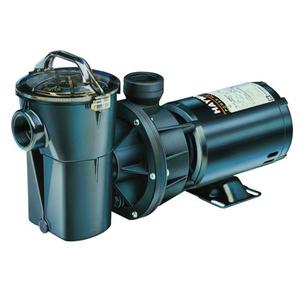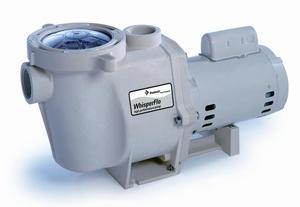Up-Rated Pool Pumps vs. Full-Rated Pool Pumps
Choosing the right pump and motor for your pool is important when it comes to the proper care and maintenance of your pool; and understanding the differences between a full-rated pump and an up-rated pump can help you make the right decision. The concept can be so confusing that it is actually possible to buy an up-rated pump and mistakenly assume that you are getting more horsepower for your money than a full-rated pump that really has the same horsepower rating.
The rather confusing system dates back to the 1960s when the standard service factor for the pump industry was 1.4. The service factor is based on several features which when combined together, give a number designated as the service factor number. These include the power of the motor, as well as the size of the pump’s fan and rotor and the amount of copper that the pump contains.
A major pump manufacturer, A.O. Smith, who at first made most of the country’s pool pumps, decided to add more copper and a bigger fan to their pumps, thus increasing the factor to 1.65 – the horsepower of the motor was basically the same; the only thing actually changing being the service factor variable. The rest of the pump companies then had no choice but to adopt this strategy as well - leading to widespread confusion among pool owners.
The terms full-rated and up-rated refer to the motor on a pool pump. All pumps have a small plate located on them, which displays the technical specifications of that motor. When it comes to buying a new or replacement pump, the two most important numbers that you need to look for on the plate are the service factor (SF) and the horsepower rating (HP) both of which give you an idea of the actual power of the motor. By the way, you should not be further confused by the term max-rated, which is just another way of referring to up-rated.
An easy formula can help you to make sense of these two numbers and will give you a more accurate idea of the real power of the pump. The formula is simply to multiply the horsepower number by the service factor number. An example can help: supposing you are buying a pump that is full-rated, with a horsepower of 0.75 and a service factor of 1.5. If you multiply these two numbers together, you will get 1.13, which in this case, would be the total horsepower of the pump. However, if you change the horsepower number to 1.0 and keep the service factor as 1.13 and multiply the two together, you get the same number – 1.13.
Because of the way the numbers are used, the performance of an up-rated or max- rated pump is just about the same as that of the next lowest horsepower full rated pump. Once you have understood the system, you will realize that a pump that has a higher horsepower listing and a lower service factor listing is described as an up-rated motor. The original motor is called a full-rated motor. The pumps are basically the same; they simply have different horsepower and service numbers.
As virtually all pump manufacturers use this tactic, if you are purchasing a new or replacement pump, you should first determine what the horsepower of the pump is and base your decision on that. One big difference is that a full-rated pump motor contains more copper than an up-rated pump. You will also want to take various other factors into consideration – the pump’s flow rate, the volume of water in the pool and the size of your filter. Of course, price will be an issue, as well as the company’s reputation and the terms of any warranty coverage.
Using the wrong type of motor can also potentially cause damage to your pool. A full-rated motor instead of an up-rated motor can even cause your pool’s hydraulic system to be over-worked. Using an undersized pump means that it may not turnover the water properly, possibly causing poor filtration. Many modern pools have extra features and a more elaborate design, making them more susceptible to damage. And if you are using your pump on your spa, you should be especially careful of the pump that you use – an up-rated pump instead of a full-rated pump probably won’t work as well and may even damage the spa.
Caring for your pool can seem like a full-time job sometimes – the typical pool owner will spend up to 10 hours a day during summer and perhaps 6 hours a day during the winter, running their pump. Once you have understood the difference between full-rated and up-rated pumps, you can at least be sure of buying the pump and motor that will best fit your needs.
| Above Ground Pool Pumps | InGround Pool Pumps |
Recent Posts
-
Transform Your Backyard Oasis with our Top Pool Products
Are you looking to upgrade your backyard oasis? Look no further th …Mar 15, 2024 -
The Ultimate Guide to Pool Maintenance
Owning a pool can bring endless hours of fun and relaxation to you …Mar 08, 2024 -
Top 5 Must-Have Spa Accessories for the Perfect Relaxation
Are you looking to take your spa experience to the next level? Loo …Mar 01, 2024



